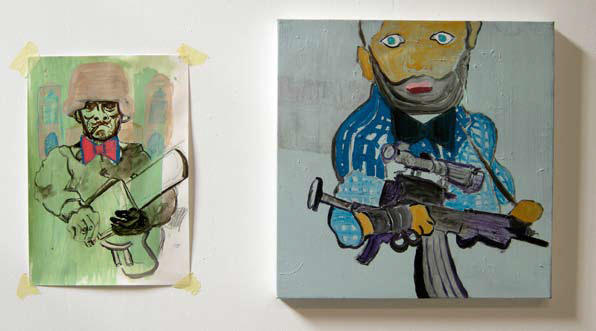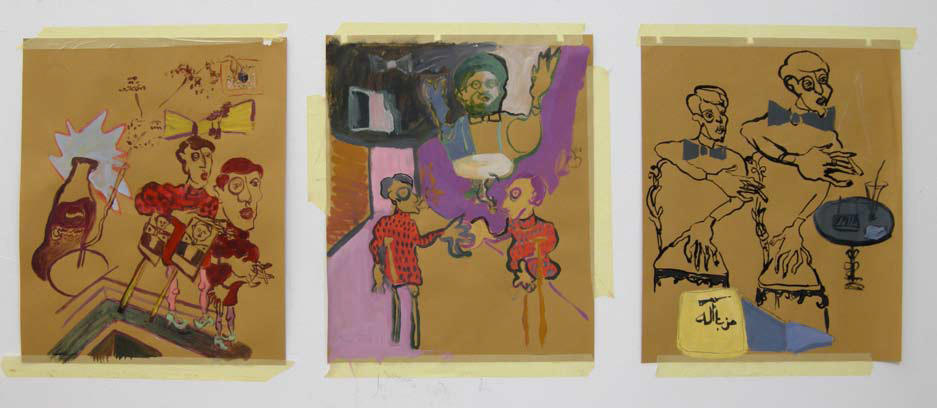
Courtesy S. Haidar
There is something delightfully thrilling about looking at Mounira al Solh’s artwork. It’s not only that she dares to address delicate issues of femininity and nationality in unexpected and even humorous ways, or that she takes on her immigrant status as a Lebanese living in Europe. Rather, it’s the intensely personal nature of her work that strikes viewers most. She puts herself, her family, and friends firmly on the line, offered up for our sometimes reluctant but always enthralled scrutiny. We’re all voyeurs by nature and can’t look away when an individual’s vulnerability is on display; but voyeurism alone isn’t enough to explain why we keep watching all the way to the end.
Over the past few years, Al Solh has become known for closely observed and intimate narrative pieces that, at first sight, look most obviously like documentaries. Works such as The Sea Is a Stereo, in which she portrays the lazy days of a group of Lebanese men who swim and sunbathe at Beirut’s Sporting Club, tell a simple story. Yet as we listen to their tales of swimming, tanning, and exercise, it’s hard to forget that Al Solh, a young woman, is the person behind the camera. The interaction is sometimes too intimate for comfort, marking a subtle line between straightforward documentary process and relationships that seem to be born of a longer history of family ties and acquaintance. As viewers, we keep watching to see if some kind of fictional mask will slip to let in the revelatory light of the real — without being quite sure what such a moment would look like. The fact that Al Solh dubs their responses to her questions with her own voice lends an effeminizing touch and only accentuates the strange tension. (It’s funny, too.)
Another video work, Rawane’s Song, takes on Al Solh’s personal emotional threshold more openly, offering an occasionally painful explanation as to why she, as an artist, can’t talk or make work about the wars in Lebanon these last years. Tracking across a studio floor as she walks, the camera moves as if her gaze is averted from our eyes. She relates her ambivalent feelings about being an artist and, occasionally, her envy of other artists’ work. A third piece, As If I Don’t Fit There, is about people’s failure to deal with personal dreams, presenting oddly posed images of young women as a series of generic immigrant artists, with texts explaining why their disposition, origin, ethnicity, or family made them abandon art for some more conventional profession. The artworks that accompany them comprise these former artists’ artistic production. Disappointingly, they utterly fail to live up to the women’s grand statements. Instead, they appear as diminished or direct copies of already existing pieces.

Courtesy Mohammad Haidar
All of these works hover around questions of belonging, identity, and the tendency to give in to conformity at some level as a woman, as an immigrant, or as an Arab in and out of one’s own society. Two works in progress extend these questions — this time through the medium of fiction. The first project, Fais ce que voudras (Do What You Want), concerns a deceased Lebanese painter named Mohammad Haidar. Al Solh’s plans include presenting a number of the late painter’s works, collecting his lost quotations, and, finally, organizing an international retrospective. Why one artist should invest so much time memorializing another is never made clear, just as Haidar’s full biography seems to have glaringly ambiguous elements. He is obsessed, for example, by Otto Dix — a potentially natural affinity for an artist experiencing war firsthand, even if under very different circumstances. But then the artist becomes equally enraptured by Rene Daniels, an artist who suffered a stroke at the height of his powers. In both cases, it’s as though Haidar has a premonition about his own early death. Or is it perhaps a sign that he’s not quite the figure he thinks he is, obsessed with notions of his own position in an artistic canon? The paintings themselves are often direct copies of familiar elements of figures, spaces, or compositions with the addition of traces of Lebanese street elements, or Arabic script indicating another location or origin. Al Solh will also reveal her discovery of two short films Haidar made with his sister.
Of course, fictionalizing facts (and vice versa) is a familiar Lebanese artistic trope. But there’s also an added layer in Al Solh’s work due to the awkward relationship depicted between a dead male artist and a living female artist, as well as the appropriation of European artistic positions — emphasizing the peculiar postcolonial conditions under which these paintings could be seen as reversing the Orientalist gaze of colonial-era Western artists. By “discovering” Mohammed Haidar, Al Solh provides herself with generous space to play with a loaded relationship between here and there, immigrant and native, that could otherwise be all too easily essentialized in European eyes. How this project will unfold in public, and the reactions it might elicit, will prove fascinating to follow.
A second work in progress is much more direct, and far more disturbing. Entitled A double burger and two metamorphoses: a proposal for a Dutch Cat, a Dutch Dog, a Dutch Donkey, a Dutch Goat and finally, a Dutch Camel, this video work will take on Al Solh herself, amateurishly made up as each of the animals mentioned. She’ll mimic their cries in an imagined conversation with a fellow member of each species. The conversations, subtitled in English, will reveal the artist’s pleas for marriage, understanding, help that will allow her to stay in the Netherlands and continue her work. Playful but harsh, it puts her in the position of an unreasonably demanding but necessarily seductive bitch — a precise and sharp description that, as an outsider in the Netherlands myself, I imagine will be only too familiar to others assuming the role of the foreign.